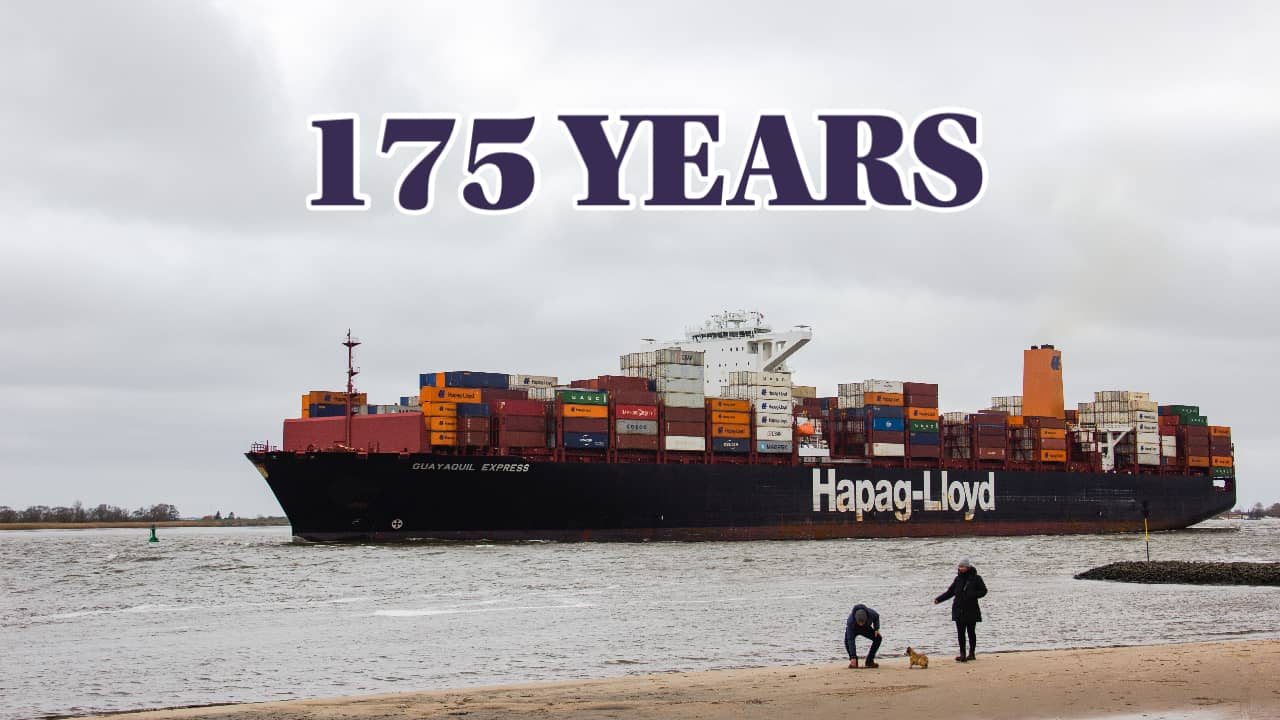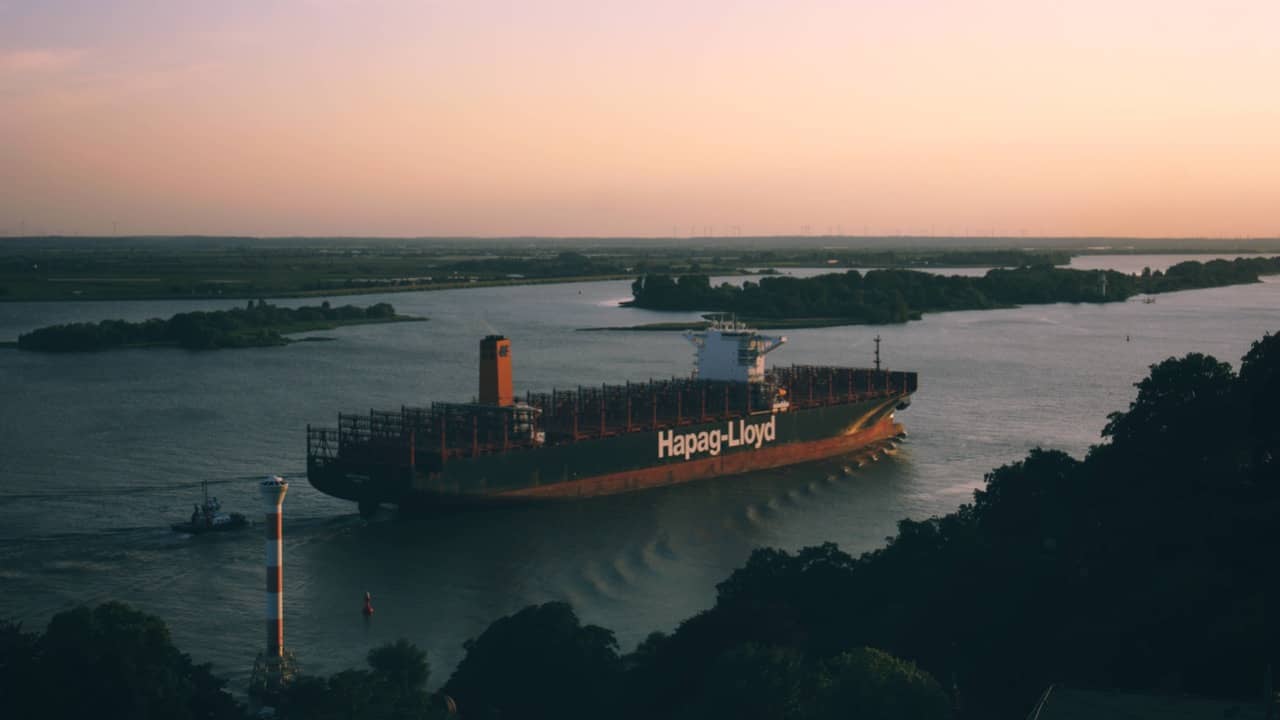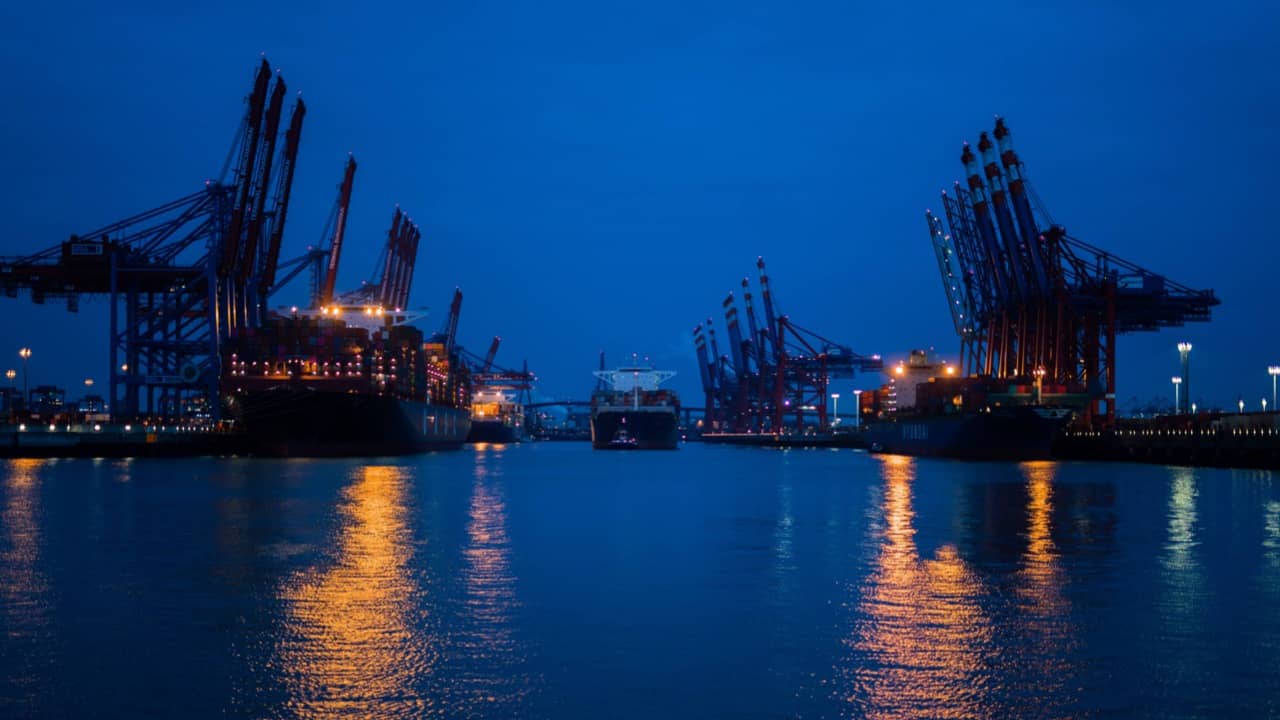
The Chaos of Here and Now for Container Shipping
On the carrier’s 175th anniversary, The Loadstar podcast editor and producer Mike King asks Hapag-Lloyd, the world’s fifth-largest container line, how the carrier is managing the chaos of the here and now?
What is being done to help shipper customers? Where will the windfalls of the last two years be spent? And what does the future hold for container shipping over the next 175 years?
Listen to the full podcast here or read the best parts below
Mike: Hello, everybody, and welcome to another episode in Lodestar’s big interview podcast series.
I have a question for you. Does anyone out there know Hapag Lloyd? I bet you do because you’ve seen their ships or the containers even if you’re not in shipping.
Hapag Lloyd is the world’s fifth-largest container line, with a global market share of just under 7%, according to Alphaliner. This interview is well-timed because the venerable Hapag Lloyd is 175 years old this May 2022.
Yes, you’ve heard that right. Hapag Lloyd was shipping cargo and passengers to New York in 1847 when Queen Victoria was on the British throne and the US was at war with Mexico over Texas.
We have Dr Ralf Belusa, Managing Director for digital business and transformation and TED Veteran on space treasures.
And in her first interview since joining Hapag Lloyd, after a high-flying career with IBM and Bosh, we have executive board member and Chief Information Officer Donya Amer.
Mike: Hapag Lloyd is now 175 years old, but you only joined the company and the board in February this year. Since then, there have been so many disruptions to container shipping.
We’ve got a stop-start of the export supply chain out of China due to COVID lockdowns. We’ve got a looming crunch on the US West Coast, where a new dockworkers deal is under negotiation. Of course, we’ve got this terrible war in Ukraine after a pandemic that has thrown the world and its supply chains into a demonic flux.
So, the question is, how are you finding liner shipping so far? Is it keeping your attention?
Donya: The last two years, the world has been more or less upside down, and it doesn’t matter which industry you are in.
Nothing is as it was before, so joining Hapag Lloyd for me was a fantastic step forward because I am now part of a company with the oldest history and the most global company I’ve ever worked for.
We are operating our business in more than 137 countries, and we are shaping our sustainable logistic future together with our teams in an even more connected world.
What I like the most about Hapag Lloyd is its open company culture. We have our values, and we live up to the values. We care, we move, and we deliver.
I see and feel it here every day when I talk to our people and customers. It’s a culture of connecting the world and connecting people with all our logistics supply chains, with all ups and downs we’re facing today in the market.
Mike: Ralf, you’ve been in this business a little bit longer, and I know you’ve had a chance to speak to Lloyd’s archivists in the head office in Hamburg.
In your research, have you found any historical precedents for this level of chaos over the last 175 years of Hapag Lloyd operations?
Ralf: That’s a good question. As a shipping company with 175 years of experience, naturally, we have successfully managed some major shifts in the markets, technologies, society, and unexpected changes and disruptions. The change is ongoing.
Looking into the company’s history, we radically altered our corporate policy by moving away from the passenger trade, or the loss of the entire fleet during the First and the Second World Wars, or the impact of the financial crisis in 2008, so this is a changing world.
But we wouldn’t be here to celebrate our 175 years as Hapag Lloyd if we had not demonstrated our capabilities and experience to adapt and change to all the events like this.

Mike: Let’s look at the here and now. We’ve had two years of record profits for the top container lines during this pandemic. The latest forecasts suggest a collective 300 billion dollars due this year. Much of this is due to higher rates because of disruptions, port congestion, etc.
Although from a liner point of view, there’s also been an effective strategy of blank sailings at various times.
We’ve had shipping lines executives in the past say that the only way out of the current scheduling and equipment mess is lower demand for services, so these bottlenecks that have built up, especially at ports, can be ironed out.
Essentially, consumers should stop spending if they want their products on time. Is that how you see it, and perhaps what is happening now as the cost-of-living crisis bites?
Ralf: Yes, as we all know that the COVID-19 pandemic and all its implications are causing many of the current disruptions along the transport chain, particularly with the ports, the terminals, the hinterland, the trucks, the rail and so on, for example, lockdown in Shanghai, so thereby limiting transport capacities and supply.
That’s one side and the other side, as we know that the current customer demand has significantly gone up in many markets due to COVID. That’s why we have had to adapt to that, thereby initiating many countermeasures initiatives for our customers to solve it and get some relief.
I just want to mention some of them, like optimizing our transport infrastructure, inter-land connections, and terminals and adding capacities as you have seen in the press with many more boxes or the additional vessels.
In addition, to further help our customers, we are improving our digital solutions, adding IT capacities and workforce to make a business as easy as it gets for our customers.
Mike: In a traditional year, we would have a mini peak in demand for the Chinese New Year as exporters try and get their shipments out before factories close in China.
Then we would tend to have a lull in the second quarter. Then it would build-up to the peak season when people are restocking inventories ahead of the holidays in the fourth quarter.
So based on the traditional demand in Q2, we get a chance to get our equipment and ships back in order and get those schedules back on track. That’s not happened due to the nature of COVID demand.
Is that more possible in 2022 because in this Q2, we’ve seen a slight drop in freight rates? But we’ve also had these closures in China due to COVID lockdowns. Is this helping you reset networks?
Donya: First of all, capacity and space are there. We have severe operational challenges, especially with terminals still being the main bottleneck. This is causing disruption and delays along the entire transport chain. Shipments are not as reliable as they should be.
We understand that this is a challenging situation for our customers. That’s why we have our best interests to make life for our customers easier.
We have already implemented many countermeasures, such as rerouting cargo in case of closures in Shanghai, shipping guarantees to offer our customers a better chance of planning, and new digital solutions, like Quick Quote Spot.
We are all hoping and expecting that liner shipping goes back to normal, and we’re doing our utmost together with other container liners. However, you can’t take it for granted that it will happen because nobody could ever imagine what has happened in the last two years.
We are trying our best to go back to a normal business environment where we have more transparency about where our containers are but overall, it’s hard for us to give a robust outlook.
We can only work with the current environment and current information status. Looking forward, it will come back more to normal by the end of this year.
Mike: These lockdowns happen so quickly. It’s hard to strategize. It’s just a case of managing that disruption.
Donya: Absolutely. Otherwise, if you’re not agile enough and are not flexible enough to react to these really big disruptions, you are in big trouble.
That’s why we are doing our utmost to support our customers’ quality and deliver the containers as expected. But if there are restrictions from governments, for example, and ports are closed, we have to react; otherwise, we don’t have a chance to be a sustainable partner for our customers.
Mike: I know many of your customers would like more reliable services. That’s not just related to Hapag Lloyd. That’s across the line.
When talking about container shipping, shippers and smaller forwarders are not necessarily complaining about high rates, even though they find them difficult to swallow. Quite often, it’s a case of actually just securing space irrespective of the price they are willing to pay on particular trades.
Some of your rivals have been quite open about this strategy to focus energies and space on the largest shippers and forwarders. Some even have said that they want to sell direct to shippers in the future.
Where does Hapag Lloyd fit into this? Are you still courting SME shippers and forwarders with a view to a future where the demand-supply equation looks a little different, and they’re still important customers for you?
Ralf: I think all customers are important. The small, the medium-sized, and the large customers. There is a demand, and we would like to support it. We want to help our customers in all aspects of the quality, delivery, and ease of doing business.

Mike: Many of your peers are investing heavily in their logistics footprint. Does Hapag Lloyd have ambitions to offer more than port to port liner services? Maybe you’re looking to start an airline, as some of your rivals?
Donya: I’m a big fan of focus. The core focus of Hapag Lloyd, at least when I decided to join this company, is container shipping. That’s where we are best in. That’s what drove us to become 175 years.
For sure, we have demand to expand our business even further. That’s what we did, for example, with the merger in West Africa but also with terminal investments like Wilhelmshaven.
These are critical investments for us, but the focus for us is container shipping. Nevertheless, investments in digital solutions are something we grow our footprint in the market.
We have a sustainable strategy we call “prepare for tomorrow”, which is our strategy to ensure that after 175 years current generation within the company supports growth to hand over a better Hapag Lloyd to the next generation.
That’s where we are simplifying our processes. We are strengthening our portfolio but still around our core business. That’s why we are investing in our people and capabilities.
But at the moment, our focus is container shipping and everything, which makes our life and the life of our customers easier.
We also invest in equipment, like vessels and boxes, for example.
We want to increase the quality for our customers with investments like Quick Quote Spot, our digital solution for customers to have a better experience when booking with us.
We’ve also invested heavily in sustainability in the last two years. We are trying to reduce our carbon footprint by 30% by the end of this decade. And, I think we are quite brave in communicating our goal to be net-zero by 2045, which is faster than expected.
Mike: To clarify those targets, you’re planning to reduce fleet emissions by 30% by 2030 and aim to be climate neutral by 2045.
How will you make sure that this is transparent to your customers? Do you plan to invest to achieve those cuts? Is 30% by 2030 enough?
Donya: In general, as ocean carriers, we have a big responsibility for combating our climate change. We are facing the challenge of ensuring that the fuel, for example, we are using to run our vessels, is available and accessible and that we have enough around the world to operate our vessels.
We have 90% of all goods worldwide transported by ship, so we can make an impact here. However, our ships only account for less than 3% of the global CO2 emissions, so that’s also something you should keep in mind when we think about the impact of our industry.
We drive the decarbonization, and the entire industry must be joining forces here. It’s nothing that just one company can do on their own.
We face a challenge of infrastructure and accessibility and need to figure out alternatives.
There’s no one big bet at the moment we can count on. We have several options in the market to tackle the challenge of climate change.
Bio-fuels, for example, are important for us, and we are investing expertise and insights to take on the challenge together with other container liners.
Mike: The key question, Donya, is there going to be enough alternative fuels available to make these emissions cut work?
Donya: If you ask me today, the answer would be no, definitely not.
First, we need more green electricity to generate these kinds of fuels, and then you have to make sure they are accessible.
It’s quite comparable to what you see in the automotive industry with electric vehicles. Everybody is saying we need more electric vehicles, but we first need infrastructure that is reliable and accessible. And also, from an economic point of view, it needs to be payable to the users.
The question then is, what are you doing with all the batteries when they pass a lifetime?
So the same discussion goes on for ocean liners and shipping. How can we make sure we do have a proper infrastructure in place? How can we join forces? How can we force science to invest more in figuring out a good solution? Do we have alternatives? Is there any other technology we never thought of to date?
Many companies are investing, and Hapag Lloyd plays a vital role in this game and is a part of the discussion and leading it in many ways.
Mike: COVID lockdowns saw many industries adapt and adopt digital technologies to improve productivity. That was also true in shipping, freight and logistics. Is there no turning back now from a tech-driven future?
Ralf: We see technology as an enabler to better serve our customers. It’s not only just simply improving productivity but also better understanding our customer needs.
We see technology as an opportunity for our customer-centric approach, which means ease of use, transparency and efficiency.
We connect to our customers on multiple online and offline touchpoints. Also, internally we are working with the latest tools available to extend further our digital product offerings and solutions for our customers.
In the end, we see technology helping us in the customer-centric approach to make our lives with the customer much easier to fulfil our quality promises. We will see technology as an enabler to better serve our customers.
Mike: Hapag Lloyd announced an investment of $250 million in tracking technology for your dry container fleet of 1.6 million boxes in late April. Is it part of this digital investment strategy?
Ralf: Yes, we are in the middle of an intelligent transformation where smart usage of data and emerging technologies will play a broader role in all of our businesses, so there is no end to digitalization. It’s accelerating, and we see that the future is automated, personalized, and optimized.
That’s why we continue investing in all digital products and solutions to meet all the customer needs and offer the benefits to our customers.
Mike: Finally, we started this interview by discussing Hapag Lloyd’s 175th anniversary. What does Hapag Lloyd or container shipping look like 175 years from now? Does it even exist?
Donya: Absolutely, I’m brave enough to say yes because we overcame a lot of changes in the last 175 years, but for sure, nobody knows what’s coming next.
We are shaping a sustainable logistic future together in an even more connected world. We are investing in many directions, not just in digital solutions but also in our people and how we would like to deal with customers.
We’re doing our utmost to give the next generation of Hapag Lloyd a high chance to be as successful as the current generation is at the moment.
I genuinely trust that container shipping is the most sustainable way to transport logistics from A to B. That’s why we are investing our time and our patience into this business.
Source: The Loadstar. This interview was edited for clarity.
P.S. Easy Freight Ltd helps New Zealand importers & exporters to save money on international freight and reduce mistakes by guiding how to comply with Customs and biosecurity rules.
➔ Contact us now to learn how we can assist you.
